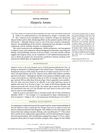A Case of Skin Disease in a Spotted Seal
March 1998
TLDR A harbor seal's skin disease was cured after 8 months of treatment.
A captive harbor seal from the Yellow Sea of Korea developed alopecia that began on its flippers and tail, eventually spreading to other parts of its body. The seal exhibited well-circumscribed lesions, and Phialophora richardsiae, Gemella morbillorum, and coagulate-negative staphylococci were isolated from the lesions and hairs. After 8 months of treatment with internal and external ketoconazole, povidone iodine, cephalexin, and multivitamins, the seal's hair regrew and the lesions disappeared completely.
